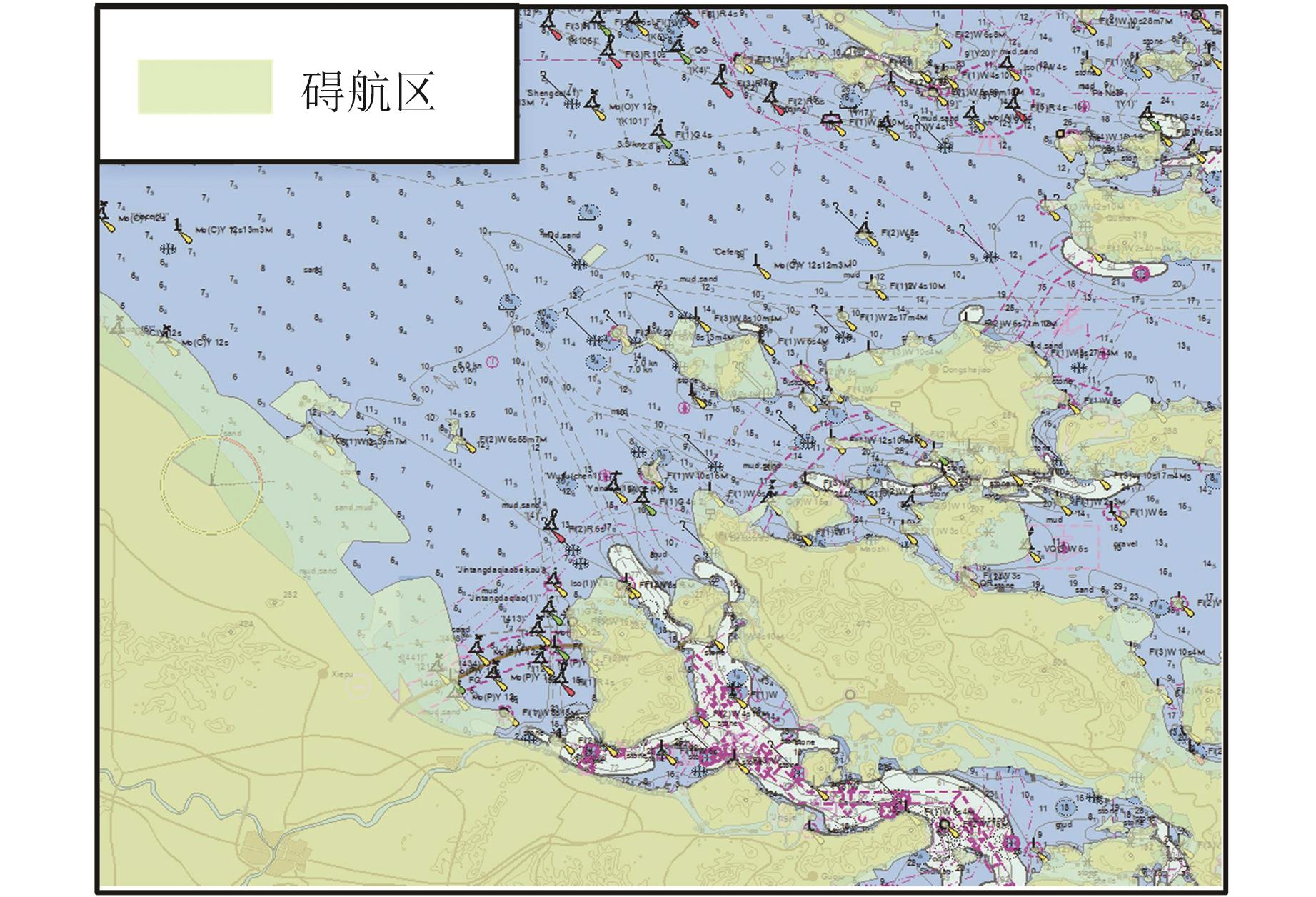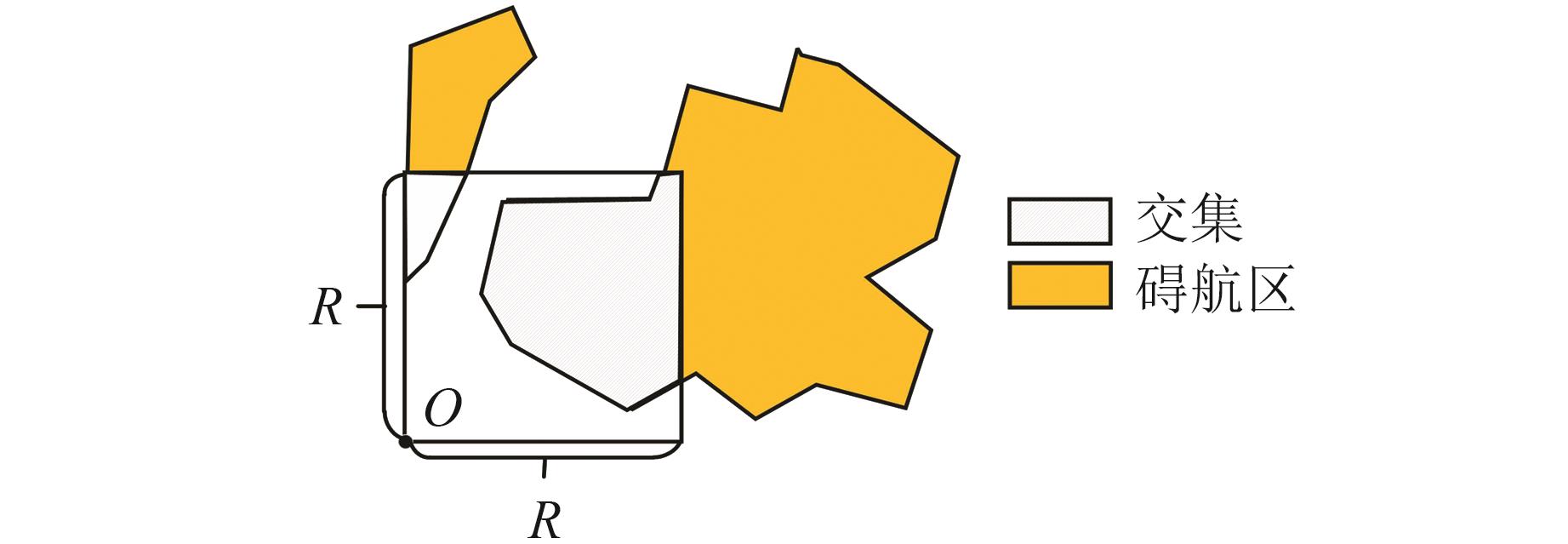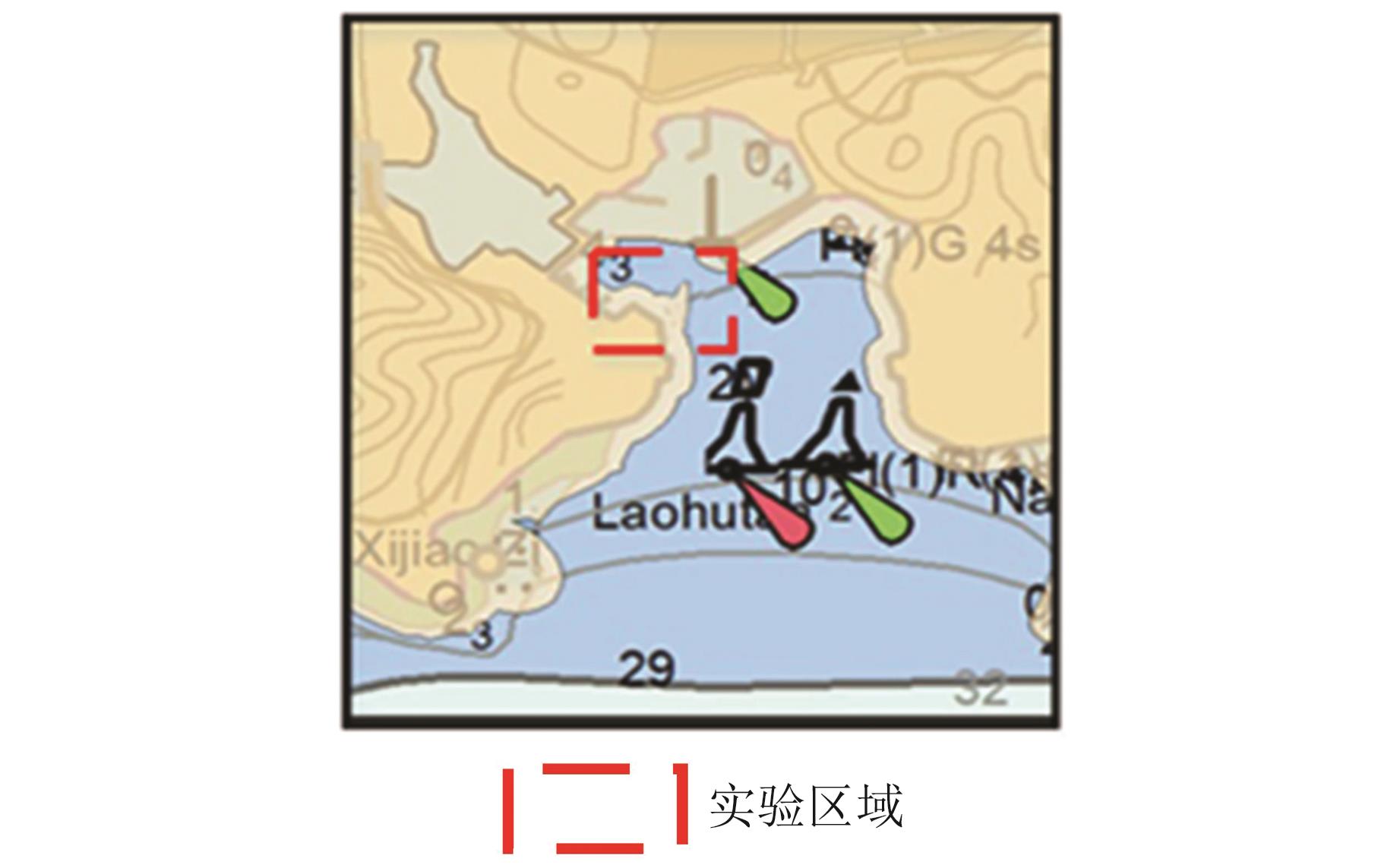Autonomous Navigation Route Planning Method of Unmanned Ship Based on Bessel Curves Constrained by Maximum Navigable Window Sequence
-
摘要:
提出了一种最大可航窗口序列约束贝塞尔曲线的无人船自主航行航线规划方法。首先,根据电子海图求取碍航区,进而预生成航路点,沿预生成航路依次提取与碍航区不相交的最大可航窗口序列,构建可航约束空间;然后,挖掘贝塞尔曲线在控制点约束包络区域内进行运动参数关联计算的潜能,将航线规划转换为空间与运动参数双约束下通过凸优化求解贝塞尔航路曲线控制点的问题。最后,分别通过仿真和实船实验,对所提方法与已有方法进行对比分析。实验结果表明:(1)所提方法能够顾及船舶运动约束来规划航线,进而有效提高无人船执行规划航线的精度;(2)所提方法可以引导无人船以特定任务所需航向、航速等运动参数自主航行通过指定位置,达到灵活机动的目的。
Abstract:ObjectiveRoute planning is the foundation of the safe and efficient navigation of ships. Due to insufficient consideration of the requirements for autonomous navigation unmanned ships, the current route planning method has two problems: (1) Own to the insufficient consideration for the motion constraints of ships in the planning route, the unmanned ship tends to produce the track deviation near the turning position and is likely to cross the navigation obstruction area while sailing autonomously. (2) The planned route is difficult to guide the unmanned ship to sail autonomously through the specified place flexibly with the course and speed for a specific task. Therefore, we propose a route planning method for autonomous navigation of the unmanned ship with a maximum navigable window sequence that constrains Bezier curves.
MethodsFirst, the navigation obstruction areas are calculated on the basis of electronic navigation charts, the maximum navigable window sequence that does not intersect with the navigation obstruction area is extracted along the pre-generated route, and the navigable constraint space is constructed. Then, the potential of the Bezier curve for the calculation of related motion parameters in the constraint envelope area of control points is excavated, and the route planning is transformed into a problem for the control point of Bezier curves through convex optimization under the double constraints of space and motion parameters. Finally, the method is compared with the existing methods through simulation and real ship experiments.
ResultsThe experimental results show that: (1) This method could effectively reduce the oscillation of track tracing of the unmanned ship at the turning position and significantly improve the tracking control accuracy of the unmanned ship. The maximum horizontal and vertical errors and variances of the track tracing of the route generated by the method are significantly less than those of the improved binary tree method of the route. (2) The actual speed and course are basically consistent with the set speed and direction, which shows that this method could guide the unmanned ship to sail autonomously through the specified place at the speed for a specific task.
Conclusions(1) The method could restrain the ship's motion to plan the route, so as to improve the accuracy of the unmanned ship effectively in executing the planned route. (2) The method could guide the unmanned ship to navigate autonomously through the specified place with the motion parameters such as heading and speed required by the specific task, so as to achieve the purpose of flexible mobility.
-
Keywords:
- route planning /
- motion constraints /
- autonomous navigation /
- Bezier curve /
- obstruction areas
-
早在GPS正式投入民用的20世纪80年代,使用全球导航卫星系统(global navigation satellite system,GNSS)作为多基地遥感系统的信号源的想法就已经被提出并很快得到了理论验证[1]。时至今日,GNSS信号已在诸多遥感领域得到了广泛应用[2]:在对地观测技术方面,GNSS信号主要在GNSS反射计(GNSS reflectometry,GNSS-R)[3-9]及GNSS无线电掩星(GNSS radio occultation,GNSS-RO)两个方向发挥作用[10-13];因GNSS信号具备与传统雷达的脉冲信号类似的测距能力,利用GNSS反射信号实现目标检测的可行性也在1995年被验证并随即得到推广[14],而今已成为多基地被动雷达系统的常用外辐射源之一。具体来说,因为GNSS信号的形式完全公开且包含精确的时间信息,其卫星的位置信息亦可依据公开播发的星历和历书进行实时解算,所以它天然地解决了多基地雷达的时间、相位以及空间这三大同步难题中的前两项[15-17]。而针对空间同步的挑战,得益于GNSS卫星辐射面广阔的特性,在系统使用宽波束接收天线的条件下空间同步的满足条件亦并不严苛。借助上述诸多优势,尽管GNSS信号并非为了雷达应用而播发,但它实则可以成为非常可靠的多基地遥感系统的天基外辐射源。
目前,使用GNSS信号作为机会辐射源的被动雷达遥感系统正逐渐显现出巨大的潜力,且该类系统对距离接收机较近(数千米级别)的动目标进行探测及参数估计的可行性已经得到充分验证。近年来,随着新体制的GNSS星座,如中国的北斗导航卫星系统(BeiDou navigation satellite system,BDS)以及欧洲联盟的伽利略定位系统(Galileo)的组网状态日趋完备,GNSS被动雷达遥感系统的实用价值也随之提升。同时,囿于GNSS信号辐射功率较低的特征,低信噪比问题长久以来一直制约着该类系统的发展和应用,相关领域中亦仍有许多亟待突破的技术难关。
本文首先总结了后向散射和前向散射两种探测体制下GNSS被动雷达遥感系统检测动目标的基本原理;然后按照两种体制的分类法进一步梳理了动目标检测的难点所在,介绍了目前学界主流的动目标检测手段和技术发展现状,并比较各类现有算法的优势与特点;最后,结合目前相关技术的发展趋势,对GNSS被动雷达遥感系统的未来研究方向进行展望。
1 基本原理
在介绍相关的遥感检测技术之前,需要先明确机会辐射源的信号形式。GNSS信号往往由数据码、测距码和高频载波3部分组成,其信号形式
可以概括表示为: (1) 式中,
为时间变量; 为信号的幅值; 和 分别为信号的数据码和测距码; 代表载波频率; 代表信号的初始相位。 GNSS信号通常被调制为右旋圆极化形式播发,而来自目标的回波信号则往往呈现出椭圆极化的特征,具体极化参数受目标结构和材质等因素影响[18]。在后向散射探测体制的雷达遥感系统中,可以认为反射信号以左旋成分为主导,因而该类系统普遍使用双通道接收机同时对信号进行采集来抑制非对应极化方式的信号成分,即通过左旋圆极化天线和右旋圆极化天线来分别接收直射信号和回波信号。另外,前向散射探测体制下的雷达遥感系统中,因为目标在前向散射区内时系统的双基地角已经接近180°,可以近似认为散射信号和直射信号具有相同的极化特征和入射角度,所以系统通常只需要一副右旋圆极化天线来接收信号。
借助式(1)的信号表达形式,系统中的直射信号
成分可以表示为: (2) 式中,
表示直射信号的幅值; 表示直射信号的时延; 表示直射信号的初始相位。与之类似地,用 、 和 分别表示反射信号的幅值、时延以及初始相位,反射信号 可以写为: (3) 用
和 来分别表示直射信号和反射信号之间的时延差和传播路径长度差,进而有: (4) 式中,
表示卫星与目标的距离; 表示目标与接收机的距离; 表示卫星到接收机的距离; 表示光速常量。 1.1 后向散射探测体制下动目标遥感检测方法
后向散射探测体制下的典型应用是监测运动模式较简单且雷达截面积(radar cross section,RCS)较大的水面运动目标。相应的双站雷达遥感系统的几何结构如图1所示,其中本地坐标系统的原点设置为接收机位置,并用
表示双基地角。 进一步引入系数
来描述 和 之间的关系: (5) 系数
的数值随着目标和卫星的相对运动而变化,但后向散射探测体制往往适用于运动较慢的目标,所以在较短的信号处理时间,如常被采 用的数秒钟的相干处理间隔(coherent processing interval,CPI)之内,可以近似认为系数
是一个常数。进一步地,使用直射信号作为参考信号,对反射信号进行距离压缩之后的结果 的复数形式可以表示为: (6) 式中,
是距离压缩后的信号幅值; 是距离维度的信号包络,常数相位项则忽略不计。 当回波信噪比足够高时,形如式(6)的距离压缩结果足以让系统完成目标的探测及径向距离的估计。但为了进一步提高信噪比以及准确估计目标的运动参数,在典型的信号处理流程中,脉冲化的回波会被排列成二维矩阵并在方位向进行时频转换。为了推导出更简洁的信号形式,不妨假设目标相对接收机做理想的匀速直线运动,则目标和接收机的径向距离可以表示为
( 和 分别为采样起始时刻目标的径向距离和径向速度)。那么二维信号矩阵在经过方位向的离散傅里叶变换(discrete Fourier transform,DFT)处理之后会被转换到距离向时域方位向频域,也就是距离多普勒(range-Doppler,RD)域。此时的信号形式 可以被表示为: (7) 式中,
为距离向时间变量; 表示方位向频率变量; 是和径向速度对应的多普勒频移; 则为噪声成分; 表示当前信号的初始相位,也可以解释为RD域信号中幅值峰值点的复数相位。 式(7)即为典型的后向散射探测体制下的动目标检测流程的处理结果,来自目标的回波能量已经被聚焦到和初始径向距离以及速度相关的RD单元内。因为GNSS被动雷达遥感系统的参考信号通常可被精准重构且其信息完全已知,所以系统普遍采用互相关检测器对动目标进行遥感检测。此外,因为RD域内噪声能量的分布难以预估,所以系统也常会采用恒虚警检测等自适应阈值设定方法来为检测器配置参数。当RD域中的信号峰值参数超过系统预设的阈值时,便可认为目标被检测到,而峰值所在的位置可以反演出目标到接收机的径向距离以及径向速度等参数。
1.2 前向散射探测体制下动目标遥感检测方法
对于前向散射探测体制下的动目标检测问题,因为目标穿越双基基线的时间窗口非常短暂,且回波受到目标剧烈震荡的RCS调制,所以系统往往无法将信号排列成二维形式进而使用传统的RD处理进行目标检测。但得益于在前向散射区内回波信号的幅值会产生显著变化的特点,目标往往在时域即可被有效检测[19]。典型的前向散射探测体制下的双站雷达遥感系统的几何结构图如图2所示。
在前向散射体制下,因为直达波和目标回波具备相似的极化方向和入射角度,所以接收机往往配置一副右旋圆极化天线进行单通道采集。接收信号中包含直射信号、散射信号以及噪声等成分。相应的实信号形式
可以表示为: (8) 为了明确更简洁的基带信号形式,不妨引入两个假设条件:第一,目标在穿越基线时,直射和散射信号的时延近似相等;第二,直射信号的幅值远大于散射信号。那么当高频载波、数据码及测距码均被剥离之后,基带信号的一维形式
可以简化为[20]: (9) 式中,
为信号的初始相位; 为直流成分; 为信号幅值; 为噪声成分。 接收机一侧的电磁场由与直射信号相关的直射场以及与目标相关的衍射场的总场决定。当目标相对于接收机位于电磁场远场位置时,其回波信号的衍射效应以夫琅禾费衍射为主,而近场位置则主要为菲涅尔衍射。因为前向散射区可能同时涵盖一部分远场和一部分近场区域,所以当目标进入前向散射区内时,衍射效应往往在近场和远场两种类型之间发生变化。另外,在实际工程中直射场与散射场的幅值之比与目标和接收机的距离有关:距离越大,比例则越小。概括地讲,在前向散射区内直射场与衍射场之间的关系与该时刻具体的双基构型、信号形式、目标尺寸以及目标距离均密切相关,难以一概而论并给出具体的量化表达。而关于电磁场近场和远场的界限划分,文献[21]给出了使用目标尺寸、目标视线角、信号波长以及双基基线长度为变量的理论推导。该研究认为当目标横向投影尺寸与电磁场菲涅尔半径之比的平方大于6时,可以认为目标进入近场,而该比例小于2时,则为较理想的远场。
基于上述理论,对于特定的前向散射雷达(forward scattering radar,FSR)系统可以定性地分析当目标穿越前向散射区时接收信号的幅值变化规律:若目标位于远场位置,依据适用于夫琅禾费衍射的巴比涅原理可以证得此时目标的RCS只与其形状有关,衍射信号能量被大幅增强。而与此同时,遮蔽效应因为信号以球面波形式传播而相对较弱,直射信号的能量被较大程度上保留,总场信号的幅值会呈现上升趋势;若目标位于近场位置,则遮蔽效应占据主导,巴比涅原理也不再适用于菲涅尔衍射,衍射场的强度会小于远场。若目标足够接近接收机且其阴影面积较大,其甚至会将系统的第一菲涅尔区完全遮蔽(该区域包含了直射信号近90%的能量),进而使得直射场强度被大幅削弱,总场信号的幅值呈现下降趋势。
基于前向和后向散射探测体制的被动雷达遥感技术,本质上均依赖于对散射信号的延时、多普勒频移及相位等参数的估计和分析。但在实际应用中两者的信号处理方式和适用的探测目标类型上则大有不同,这导致二者在检测流程中的一些近似条件并不通用。例如,因为前向散射探测体制往往用以检测高速的空中目标,那么系数
不再可以视为常数,进而导致 一项成为时变项,令接收信号的多普勒频移发生变化。事实证明在目标穿越基线的一段时间内,散射信号会呈现出明显的线性调频(linear frequency modulation,LFM)特征。在实际工程应用中,前向散射探测体制下的GNSS被动雷达遥感系统通常便利用上述的信号幅值变化规律及对应的时频关系来定性判断目标是否出现。 2 关键技术及研究现状
对于一般意义上的被动雷达遥感系统应用场景,在发射源不可控的同时,也存在着多径效应和杂波干扰等现象。因此该类系统的直射信号提纯是一个关键难点,通常需要使用杂波抑制和信号恢复算法进行预处理以期获得纯净的直射信号成分[22]。但对于GNSS被动雷达遥感系统来说该过程则较为简便,因为根据完全公开的信号体制和调制方法,相应的数字接收机可以高效完成直射信号的参数提取并据此重构纯净的参考信号。具体来说,当作为机会辐射源的卫星可见时,系统可通过GNSS接收机的跟踪环路中载波环和码环输出的多普勒频移及码相位信息精准重构直射信号成分。此外,信号中的杂波和多径干扰等成分会初步通过天线的极化方向得到抑制,并进一步地借助跟踪环路的相关和积分运算被再次滤除。所以对于GNSS被动雷达遥感系统的目标检测问题,回波信号的提纯和能量聚焦往往是主要难点所在。下文中本文按照后向散射和前向散射的体制分类法,依次梳理相应的关键技术和研究现状。
2.1 后向散射探测体制下动目标遥感检测关键技术及研究现状
2.1.1 帧内回波能量聚焦技术
在后向散射探测体制下,一段时长为CPI的二维信号被称为一帧,而能量的聚焦则分为帧内和帧间两种类型。帧内的能量聚焦通过距离向的匹配滤波或脉冲压缩,以及方位向的DFT实现,这也是经典的雷达系统动目标检测方法。对于回波能量不足的弱目标探测问题,目前主流的做法是在保证帧内信号相干性的前提下,延长CPI进而获得更充分的能量积累。然而对于特定的点目标,当其在帧内发生跨越距离单元和频率单元的走动时,帧内的信号相干性会被破坏,来自目标的回波能量无法聚焦在一个RD单元内,进而导致能量的散焦[23-24]。帧内能量聚焦的关键技术可以分为距离徙动(range cell migration,RCM)校正和多普勒徙动(Doppler shift cell migration,DCM)校正两类。一帧典型的经过RCM和DCM校正的水面动目标实测检测结果如图3所示。其中目标在RD域中的位置以红框标识,且其多普勒频移已被换算成径向速度。
最符合直觉的RCM校正方法是直接将有关的相位项按照径向速度的数值用共轭项进行补偿,但目标的速度信息通常是未知的。文献[25]针对动目标的合成孔径雷达(synthetic aperture radar,SAR)成像技术提出了Keystone变换(keystone transform,KT)来校正图像中的RCM。这是一种无需速度先验信息的校正算法,它可以将来自没有多普勒模糊的一阶径向速度引起的RCM完全校正[25]。KT时至今日在GNSS被动雷达遥感领域仍是非常主流的算法,但KT也有它的局限性,主要便是上述的多普勒模糊问题。若雷达的脉冲重复频率(pulse repetition frequency,PRF)较低,方位向上的等效采样率也较低,那么对于径向速度的求解便可能存在多普勒模糊的问题[26-28]。针对KT存在诸多衍生变体,如文献[27]提出的改进的KT(modified KT,MKT),解决了多普勒模糊的问题,但不可避免地增加了算法复杂度。文献[29]提出的对称KT(symmetrical KT, SKT),借助两次二阶KT则可以同时校正一阶和二阶的距离走动,但与此同时会丢失奇数阶的DCM参数,使得后续的参数估计工作变得更加复杂。在另一个思路上,系统也可以对预设范围内所有可能的速度进行搜索进而实现RCM校正。因为一阶RCM会导致脉压峰值在二维的雷达信号图中呈现线性走动,那么可以借助拉东(Radon)变换来搜索该斜率进而对其进行校正,这也是目前比较主流的拉东傅里叶变换(Radon Fourier transform,RFT)的原理[30-31]。相较于KT,RFT的优越性在于可以同时得到多普勒频移以及目标的径向速度信息[32],而该算法亦拥有一些针对特定阶数运动的派生变体,例如文献[33]提出的可以额外校正一阶DCM的改进的RFT(modified RFT,MRFT)。RFT更具普适性的变体是文献[34]提出的改进的通用RFT(generalized RFT,GRFT)算法,将算法的一维走动修正限制提升至任意维,理论上在信噪比足够的条件下可以校正用N阶多项式表示的RCM和DCM。但同样地,GRFT作为一种高维搜索算法,算力开销也比KT更大。表1整理了几种主流的RCM校正方法的特点。
表 1 主流RCM补偿方法比较Table 1. Comparison Amongst Mainstream RCM Correction Methods算法 补偿阶数 基本原理 特点 KT 1 重映射距离向时间轴 无需速度先验信息,无需搜索;存在多普勒模糊问题 MKT 1 补偿掉与多普勒模糊数相关的相位项,并重映射距离向时间轴 无多普勒模糊问题;复杂度较高,需要反复执行KT SKT 2 使用正负重映射参数分别对信号进行二阶KT并相乘,用以移除相关相位项 可同时校正一阶和二阶RCM,但导致奇数阶DCM参数丢失 RFT 1 使用Radon变换求解目标轨迹的斜率,并对速度和距离进行联合搜索 可在校正RCM的同时获得目标的速度信息,但需要帧内目标速度保持不变 MRFT 1 在RFT基础上增加调频率搜索 可以在校正RCM的同时对一阶DCM进行校正,但要求帧内不存在二阶RCM GRFT N 将目标运动表示为N阶多项式并对相关参数进行遍历搜索 理论上可以在任意时间长度上通过高维搜索实现任意动目标的运动补偿,但实际应用中仍旧需要指定具体阶数 DCM的数值与目标及卫星的加速度有关。卫星的运动参数是已知的,但目标的运动参数则是有待估计的,所以DCM校正本质上需要对慢时间频域信号能量分布进行检测。考察频谱能量分布最简单的办法是利用DFT直接进行时频转换[35],然而当目标具备高机动性且需要的能量积累时间较长时,频率随着时间的变化会更加复杂,该方法带来的能量聚焦便不足以实现目标的检测和参数估计。这种情况下需要使用时频分析方法来找到频谱能量的分布规律,再进一步根据频率随着时间的变化来进行频率补偿,最终实现帧内回波的聚焦。时频分析方法可以大致分为线性和双线性两种类型,前者对于具备多个时频调制成分的交叉项抑制效果更好,但在时频域的能量聚焦效果相对有限;后者则具备更好的能量聚焦效果,不过相对地会在时频域中引入更多不同信号成分的交叉项。
文献[36]提出的离散分数傅里叶变换(discrete fractional Fourier transform,DFrFT)是一种简单有效的线性时频分析方法,它针对具备径向加速度的目标回波进行时频分析,在实现能量聚
焦的同时也可以借助目标的峰值位置信息反演出径向加速度的数值。DFrFT目前是比较流行的时频分析方法,但它只能解算一阶的多普勒走动[37-38]。文献[39]基于DFrFT提出了在多普勒质心-多普勒调频率(Doppler centroid- Doppler frequency rate,DC-DFR)域对动目标进行检测的思想,该算法将RCM校正之后包含目标回波能量的方位向数据的DFrFT结果中的频率和旋转角度数据分别映射为多普勒质心和多普勒调频率,更为直观地展示了经过能量聚焦后的弱目标检测结果。文献[40]将KT的尺度映射思想引入到维格纳准概率分布分析上,提出吕分布(Lv’s distribution,LVD)时频分析方法。该方法通过重新映射信号的对称参数瞬时自相关函数实现了信号的时间变量和自相关的时延变量的解耦,让线性调频信号在中心频率-调频率域成为一个独立的点,以实现信号调频率的估计和解调。该方法结合了线性和双线性时频分析方法的优点,是目前较为先进的时频分析手段,但该方法在GNSS被动雷达遥感系统中的应用目前较少。文献[41]提出了基于相邻相关函数的非搜索RCM校正方法,便利用了LVD分析可以校正加加速度引起的距离走动的特点,并使用仿真实验进行了验证。该方法首先利用相邻相关去除RCM并降低DCM的阶数到一阶,再利用LVD分析解调其调频率,进而实现目标回波能量的聚焦。该方法全程未使用搜索的思想,但本质上利用了相邻信号的高自相关特性,其可行性在实测数据上,尤其是GNSS被动雷达遥感数据上的适用性还有待研究。其他主流的时频分析方法,如短时傅里叶变换(short-time Fourier transform,STFT)和小波变换(wavelet transform,WT)等,均具备在某些特定条件下解算目标径向速度随时间变化的能力,亦并不局限于对一阶DCM分析,但上述两种时频分析的方法的通用性均不高,对信号本身的信噪比有较强的依赖性[42-46]。另外需要注意的是,上述的时频分析方法本身并不等同于DCM补偿,而是求解DCM数值的过程,后续的补偿可以根据算法给出的数值在复数域直接令信号与共轭项相乘来实现。表2整理了上述几种主流的多普勒频移时频分析方法的特点。
表 2 主流多普勒频移时频分析方法比较Table 2. Comparison Amongst Mainstream Time-Frequency Analysis Methods for Doppler Shift算法 补偿阶数 基本原理 特点 DFrFT 1 在时频平面按照任意角度进行分数阶傅里叶变换 属于线性时频分析方法,不存在交叉项,但本质上是对调频率的遍历搜索,复杂度较高 DC-DFR分析 1 对DFrFT数值进行重新映射,得到多普勒中心和调频率数据 本质上依旧是DFrFT,但可更直观地考察信号特征和所需估计的参数 LVD分析 1 针对信号的对称参数瞬时自相关函数,引入类似KT的时间轴重映射思想,解耦时间和时延变量 结合了线性和双线性时频分析的优点,理论上具备当前最佳的针对LFM信号的分析性能 STFT N 将时域信号加窗分段,并逐一进行傅里叶变换 线性分析方法,并不局限于特定阶数的时频关系分析,但结果的可用性高度依赖于每段信号的信噪比 WT N 使用一组小波基对信号的频率成分进行逼近和分解 线性时频分析方法,可以很好地分析具有频率突变特征的信号的时频分布,算法的复杂度相对较高 综合来讲,除了KT以及LVD分析,目前较为主流的RCM和DCM补偿方法均基于搜索的思想,而搜索结果的判断则有赖于接收信号的信噪比。倘若原始回波信噪比较低以致在RD域内难以检测到目标峰值,这些分析方法便很难奏效。从另一方面考察,搜索的过程需要对目标运动进行多项式估计,以便对特定参数进行有针对性的解算。当目标的机动性较高时,低阶多项式对目标的运动表达将不再充分,而高阶多项式对应的搜索过程则具有呈指数级上升的时间开销,这并不符合雷达系统的性能要求。进一步地,若系统能接受的多项式阶数有上限,则其CPI的选择亦是受限的。最大CPI的数值和多项式阶数息息相关,理想情况下任何运动过程都可以用多项式来拟合,但其阶数可能远超系统限制,所以帧内回波能量聚焦的效果对于高机动性、小RCS的目标往往并不理想。
2.1.2 帧间回波能量聚焦技术
目前,针对GNSS被动雷达遥感系统帧间的回波能量积累技术,或者多帧检测(multi-frame detection,MFD)技术的相关研究较少。其根本
原因在于当单帧数据无法成功检测目标时,帧间的RCM和DCM会处于无法预估的状况。此外,帧间的信号相位走动受噪声、杂波以及目标闪烁等因素影响,亦是完全随机的。
普遍意义上,后向散射体制下的MFD思路主要分为两种,首先是通过同一颗卫星的不同时刻的数据帧的积分对目标的回波能量进行聚焦。文献[47]在使用GNSS信号检测水面目标的任务中提出了一种将RD域数据映射到本地坐标系的思想,并通过实测数据对其可行性进行了验证。该算法首先将回波信号分割为一系列CPI为1 s的帧,再为目标可能的速度矢量和初始位置进行预设,依据每一组可能的值产生的目标运动历程在RD图序列中提取对应的单元内的能量进行非相干叠加。该检测方法本质上是一个4维搜索过程,通过非相干积累实现了弱目标回波能量的帧间聚焦。文献[48]针对该类问题又引入了主动雷达的检测前跟踪思想对GNSS被动雷达遥感系统的帧间回波能量聚焦进行了尝试,成功在RD域实现了对弱目标的检测。但该类方法的劣势在于算法复杂度较高,当子问题尺寸较大时并不适合实时处理[49-51]。文献[52]则利用高帧率图像序列技术来检测RD图序列中能量的变化,进而对空中目标实现MFD,提供了比传统检测方法更高的处理效率。
第二种MFD思想是将多基地雷达的回波信号进行融合并对目标进行联合检测,这其中又可以分为多星单接收机(multiple input single output,MISO)系统、单星多接收机(single input multiple output,SIMO)系统以及多星多接收机(multiple input multiple output,MIMO)系统3种,MISO系统目前较为主流。对于分布式系统的联合检测问题,其关键难点在于如何将多个信源的数据有效配准。如文献[53]实现的多基地雷达对水面动目标的联合检测,使用了文献[54]提出的多星信号配准方法。该方法利用单颗星回波解算出的双站构型参数如双基地角等作为标准,对不同卫星回波信号中目标坐标位置的差异进行修正。文献[55]提出使用迭代校正器多伯努利滤波器对多信号源得到的检测结果进行联合处理,并更新其中低信噪比的结果进而提高RD图序列中目标可见性的算法,用以实现MISO构型雷达系统的目标检测,并在2020年通过实验验证了该算法对空中目标的检测能力[56]。该算法本质上是一种基于统计信号处理理论的多传感器融合过程,依赖于每一帧信号的检测结果提供的目标信息。文献[57]提出在目标运动参数空间中映射多颗卫星检测结果,对目标实现联合检测,但其帧间的信号配准借助了单颗卫星检测的先验信息。文献[58]提出使用多组双站GNSS被动雷达遥感系统对目标的参数进行联合估计,亦基于类似的思路,依靠多组单帧的检测结果融合来提高参数估计的准确性。
在极低信噪比的前提下,若在每一帧回波中系统都无法单独解算目标信息,则目前还未有较好的方法可以实现多信源能量的聚焦。其原因便是目标位置和参数的不确定性导致无法配准的多路信号难以进行有效的能量积累,这无疑是目前该领域亟待解决的难题之一。这种帧间信息差的不可预估也导致了在帧间的能量积累方式上,目前广泛采用的是可以不顾及相位差异影响的非相干积分[59]。不过目前已经有部分研究开始探索帧间的相干积分方式。如文献[60]提出了帧间相干性补偿方法,在理论上证明了具备相干性补偿的MFD技术可以带来更高的检测概率,该理论亦在2023年通过了实测数据的验证[61]。又如文献[62]通过仿真实验验证了帧间相干积分的信噪比增强效果。不过上述两种方法均建立在对帧间相位走动的建模和估计之上,原则上来说只适用于较为理想的高信噪比且运动模式可用低阶多项式较好拟合的目标检测任务。在实际的动目标检测问题中,帧间的相位走动往往是没有任何规律可循的。
2.1.3 动目标定位及成像技术
当动目标的探测和参数估计完成时,系统可进一步对目标进行定位、跟踪以及逆SAR(inverse SAR,ISAR)成像等后续处理。其中水面动目标的定位和跟踪技术已经较为成熟,因高度信息相对稳定,所以可以较为方便地在一个二维平面上解算其空间位置。本地坐标系4维搜索算法事实上可以实现目标在水面平面上的定位[47],但具备不同初始位置和速度矢量的目标完全可能拥有相同的RD历程[57],所以算法应该针对此问题进行进一步优化。若系统的信号源不局限于单颗卫星,则可利用MISO系统的多星检测结果来实现交叉定位,进而避免上述的定位模糊问题。如文献[63]使用Galileo作为机会辐射源搭建的MISO雷达遥感系统实现了对水面动目标的有效检测,利用的便是椭圆定位的思想。类似的技术还有文献[64]提出的使用GPS回波信号对目标进行交叉定位的方案,以及文献[65]利用两颗卫星对目标进行联合定位的方法。上述定位方法也被称作两步定位法,需要先解算回波信号中和目标相关的参数,如传播时延、到达角以及到达频率等参数,并进一步在空间中寻找同时符合上述解算参数的位置来实现目标的定位。该类方法在空中目标的外辐射源三维定位问题中亦有相关应用,如文献[66-67]提出的针对GNSS外辐射源空中目标交叉定位方法中不同信号源的贡献进行加权的思想,其可以突破实际工程中卫星高度角越低则定位性能越差的局限性,并分别用仿真和实测数据验证了该方法对空中目标定位精度的提升。若系统可以接受更高的计算复杂度,亦可直接从多个原始回波中根据目标相关参数的关系直接实现定位,避免两步定位法引入的中间参数计算。文献[68]提出了使用BDS卫星作为外辐射源的目标直接定位方法,该研究建立了脉冲压缩之后的信号关于目标位置和速度估计的似然函数,通过求得相关参数的最大似然估计的方法实现目标定位。此方法的定位性能可以逼近系统的克拉美罗下界,但该研究中的目标位置和速度在仿真实验中均被设置为二维矢量,所以相关算法在实际工程中的目标定位效果还需要针对三维位置和运动参数的实测验证。
在动目标成像技术方面,文献[69]使用单站GNSS反射信号对水面动目标实现了ISAR成像,图像中可清晰观察目标在方位向的能量展宽。类似地,文献[70]成功使用多基地BDS被动雷达遥感系统对水面动目标进行了ISAR成像。在积累时间内,目标由于发生转动而导致不同散射点具备不同的多普勒历程,而该算法便依照上述区别对目标的回波能量在方位向进行投影,并进一步通过非相干积分融合多颗星之间的成像结果。此外,倘若目标沿着垂直于接收机的视线方向做直线运动,那么也可以利用传统的SAR成像技术对回波能量进行映射。例如文献[71-72]提出的水面动目标成像技术利用了目标转动时其多个散射点呈现出的不同多普勒历程反演出目标上不同散射点的位置信息。然而事实上受限于GNSS信号较低的距离分辨率,目标在距离向的能量分布仍然难以被清晰观察,所以真正意义上的目标二维成像技术还处于早期探索阶段。
2.2 前向散射探测体制下动目标遥感检测关键技术及研究现状
2.2.1 前向散射回波信号提纯技术
使用GNSS信号的FSR系统通常只设置一个接收通道,并无参考通道和回波通道的区分,所以接收通道内混杂着直达波、目标回波以及噪声等成分。为了获得尽可能纯净的散射信号,需要对接收通道内的非回波成分进行滤除,这是目前相关应用的难点之一。理想状况下,在载波和测距码都已被剥离且数据码均翻转到正电平的情况下,可以近似认为直射信号已经被压制成直流成分。所以目前常用的回波提纯手段是在跟踪环路输出的结果中,使用陷波滤波器直接滤除和直达波对应的直流成分[20]。当然,因为GNSS信号跟踪本身是一个不断调整参考信号生成参数以逼近接收信号的闭环自动控制过程,所以环路的输出结果不会完全和直射信号吻合,这也为直达波的估计引入了不可避免的误差。对于残留的噪声成分,通常用低通滤波器来对相关的高频成分进行抑制。上述的载波和测距码剥离之后使用陷波滤波器配合低通滤波器的方案通常可以较为有效地从接收通道中提取出具备LFM特征的实数散射信号,而实信号可以通过分段希尔伯特变换重构为复信号进行后续处理[21]。当前亦有部分研究提出了对于散射信号提纯的更精细化的处理方案,如文献[73]提出的基于子空间投影的直射信号抑制算法,其本质上是将信号映射到和直流成分垂直的子空间上进而滤除该类成分。子空间投影在传统的FSR系统中是非常经典的杂波抑制算法,也派生出诸多衍生技术,如扩展相消算法[74]和扩展相消批处理算法等[75]。然而该类子空间投影算法依赖的是对杂波的建模和搜索,这往往只在信噪比较高或杂波成分具备一定先验信息的条件下才可以执行[76-77]。针对GNSS FSR系统相关应用中常见的极低信噪比的情况,相关的信号提纯技术还有待进一步研究。
2.2.2 动目标检测器
通常意义上可以认为当FSR系统的双基地角大于135°时目标处于前向散射区内[21,78],而在广阔的待检测空域中,要求目标穿越该区域是较为苛刻的构型条件。在GNSS被动雷达遥感技术近30年的发展历程中,关于使用前向散射信号进行目标检测的工作较为少见,但倘若不限制辐射源为GNSS信号,相关研究成果则相对丰富。如文献[79]给出的使用Wi-Fi信号的FSR系统的车辆目标检测的实验结果,文献[80]利用广播信号对在前向散射区内的空中目标实现了有效检测。上述两种信号的到达功率相对于GNSS信号来说有显著优势,所以相关的时频分析也较为简便,如在文献[79]的实验中,系统可以直接对目标穿越基线的信号段进行RD处理来实现目标的运动参数估计。但在GNSS FSR系统中动目标的探测通常借助回波信号的幅值变化来实现,如文献[81]提出的动目标检测方法、文献[82]推导的在无RCS调制下的前向散射信号形式,均在理论上为该类目标检测方式提供了支持。而在实验验证方面,文献[83-84]均展示了可靠的空中目标探测结果,但这类检测手段通常针对被遮蔽效应调制的信号而设计,所以适用范围受到目标尺寸和目标飞行高度的限制。事实上除了文献[14]对多种飞行器的穿越前向散射区时信号幅值变化规律的测试以外,目前还较少有利用增强效应实现目标检测的成果。典型的受遮蔽效应调制的空中目标回波幅值变化如图4(a)所示,受前向散射RCS增强效应调制的结果如图4(b)所示。
形如图4(a)的幅值变化特征被认为是FSR系统检测到目标的可靠依据,但目前相关研究内并未给出被广泛认可的定量标准,即何种程度的回波幅值变化可以表征目标被正确检测。尽管对于使用其他辐射源的FSR系统已经有可靠的检测器被提出,如文献[85]提出的针对频率调制信号的晶体视频检测器,以及一般似然比检测器[86],但针对GNSS被动雷达遥感系统来说目前还鲜有相关工作。综上可见,当前学界的相关研究主要集中在较近距离的大RCS目标的检测任务上,且缺乏具备量化标准的检测器。对于远距离的小RCS目标,还需要更多基础研究来明确其回波信号的调制方式,进而设计相应的检测方案和参数估计算法。
2.2.3 动目标参数估计及轮廓成像
当目标被系统成功检测后,则可以进一步实现对目标相关运动参数的估计,包括多普勒调频率、运动速度以及穿越基线时刻等,其中对于调频率或者多普勒历程的搜索是FSR系统目标参数估计最关键的问题之一。当目标回波的多普勒历程已知,便可以通过遍历速度矢量以及目标穿越基线时刻来寻得和多普勒历程相匹配的真实参数[21]。回波信号的多普勒频移由目标在双站构型中的运动产生,而在目标穿越前向散射区内的一小段时间内,往往可以认为目标的绝对速度是恒定的。与低斜视角的SAR成像技术相似,当忽略掉高阶的距离变化参数后,可以近似地认为目标的多普勒频移在这段时间内满足LFM形式,而其调频率与目标速度以及整个双站系统的构型参数有关[87-91]。不过在LFM信号上还调制着震荡的目标RCS,所以难以使用传统的解调频或者DFrFT等整体分析方法实现对调频率的搜索,而只能借助STFT一类的分段时频分析手段求得目标在前向散射区内不同时刻的频率变化。图5(a)展示了一段有实测空中目标穿越的时长约为1.2 s的回波信号幅值历程,相应的原始信号已经过直流成分及高频噪声滤除处理;图5(b)是该信号段的实信号STFT时频分析结果,可以看到明显的用黑色虚线标识的LFM特征。当获知多普勒调频率之后,系统便可以结合双站构型参数遍历搜索出目标的运动速度及目标穿越时刻等运动参数。文献[92]也提出了从FSR系统回波的频谱中直接对速度进行估计的思想,并使用水面目标进行了实验验证,其利用了目标速度越快则多普勒变化率也越高的时频特征,但该方法对空中目标的适用性还有待进一步探索。
因为FSR系统不具备距离分辨能力,所以传统的雷达成像技术无法直接应用在该类系统上,但在获知回波信号的多普勒调频率以及对应的多普勒历程之后,目标穿越基线时的轮廓可以被有效重建。在前向散射区内,目标的复散射信号可以看作是与目标多普勒有关的复数相位以及与目标形状相关的时变衍射成分的叠加。其中,前者可以根据已知的多普勒信息进行补偿,而后者可以看作是目标复轮廓函数(complex profile function,CPF)的菲涅尔变换。因为CPF的幅值和相位分别对应目标的高度差像和中线高度像,所以对多普勒补偿之后的剩余成分通过菲涅尔逆变换求得目标的CPF之后便可解出目标的高度轮廓[93]。故而目标轮廓信息的求解本质上是基于复散射信号的重建,上述过程便是适用于空中动目标的小衍射角条件下的阴影ISAR(shadow ISAR,SISAR)成像技术的基本原理[94]。值得一提的是,文献[95]在给出空中目标的SISAR实验结果的同时,也指出了目标的复散射信号的功率谱特征同样和目标的轮廓直接相关,进而可以借助相关特征对空中目标实现进一步的分类。
倘若将问题重新聚焦回GNSS FSR系统,由于双基构型时刻发生变化,且其信号到达功率通常较低导致多普勒调频率求解较为困难,所以SISAR成像在该类系统中的应用较少。在较为严格的构型限制下,文献[20]提出了使用GNSS信号作为辐射源的前向散射雷达的SISAR成像技术,借助目标穿越基线时产生的复散射信号对接收机正上方1 km高度的民航客机的顶部轮廓进行了成功的描绘。但其研究亦指出该技术的应用受双基构型和目标尺寸的限制,当目标位于近场位置时,虽然根据遮蔽效应对目标实现检测较为直观,但同时该类构型下目标回波的多普勒信息基本完全丢失,导致参数识别及SISAR技术无法应用。该项技术是否可以推广到更宽松的FSR构型下,还有待深入研究。此外,文献[96]提出了使用稀疏自动编码器和BDS信号的FSR系统目标识别技术,直接在目标的SISAR成像结果上实现了目标分类,并使用仿真数据验证了该项技术的可行性,为GNSS FSR系统的动目标识别工作提供了与利用功率谱特征进行分类的不同思路。
3 技术展望
GNSS外辐射源雷达遥感系统的动目标检测技术目前的发展阶段仍旧处于适配传统雷达技术的阶段,但事实上使用GNSS信号作为机会辐射源的真正优势在于该类系统同时拥有数量众多的信息完全公开的可见卫星。所以向着多信号源融合的方向探索,最终形成分布式MIMO系统,是属于GNSS被动雷达遥感技术的特色道路。此外,后向散射雷达的帧间相干积分以及两种体制下的动目标成像,也是具备高可行性的发展方向。
3.1 后向散射探测体制下动目标遥感检测技术展望
如前文所述,当前的后向散射探测体制下的帧间能量积累主要依赖非相干积分来实现,但事实上因为噪声的相位随机性,使用相干积分可以进一步削弱噪声成分能量进而带来更高的信噪比增益。不论对于SISO构型下的帧间积累还是MISO构型下的多星数据融合,相干积分都需要首先对不同帧的二维信号进行参数配准,其中包括目标峰值在RD域中的位置以及峰值点的复数相位。目前,针对传统雷达的MFD问题已有关于相干性修复的技术提出,如文献[97]提出通过高维搜索算法对不可预估的多维度信号帧间相位差异进行修复。虽然在GNSS被动雷达遥感领域中还较少有相关成果,但事实上因为在讨论通过多帧信号融合实现信噪比增强的语境中往往隐含着单帧数据并不具备目标可见性的前提,所以在帧间相干积分技术上GNSS信号和传统雷达信号并无本质差异,对此类问题尝试适配主动雷达的相关解决方案依然不失为是实现突破的方向之一。此外,积累同一颗可见卫星的多频带目标回波能量亦是实现相干MFD的潜在解决方案。因为同一颗GNSS卫星可能在多个频点同时播发信号,但接收机一侧则通常只对特定频带内的信号进行接收和解调,这无疑舍弃掉了一部分信号能量。而该方案的优势也在于对于来自同一系统且同样时间下的不同频带的回波数据帧,其中目标的运动特征必然完全一致,所以其回波能量积累过程无需对帧间的RD域峰值位置差异进行校正,相关算法的开发可以更多关注复信号的相干性补偿方法。
3.2 前向散射探测体制下动目标遥感检测技术展望
当单一前向散射区内的回波信号无法检测到目标穿越时,是否可以通过结合多个前向散射区内的回波信息对目标进行联合检测,是目前亟待解决的问题之一。文献[18]在理论层面探讨了MISO构型FSR系统的目标探测概率,指出在该构型下FSR系统比后向散射体制系统具备更高的探测能力。虽然后向散射体制的构型要求更容易满足,但FSR系统的高信噪比特征在实际应用中更具优势,所以如何利用多信号源对目标进行联合检测是提升系统检测性能的重点。不过该问题与后向散射体制的MFD问题大有区别,因为FSR系统中并没有帧的概念,系统往往在一维时域对目标进行检测。当前缺少有效的技术手段将目标穿过不同基线的能量变化累积起来以实现微弱能量波动的检测,而倘若此问题得到有效解决,那么MIMO雷达遥感系统的双基基线组成的前向散射区网络将会实现非常高效的弱目标甚至隐身目标的检测和跟踪。针对类似的问题,当前已经有部分理论探索和实验成果,如文献[98]定性分析了MIMO FSR系统使用GNSS卫星作为信号源的优势,并用实测数据验证了MISO构型下目标联合检测的可行性。类似地,文献[99]用仿真实验搭建了MIMO FSR系统,在只使用目标穿越时刻这一参数的前提下实现了目标的检测及运动参数的估计。
MIMO构型下FSR系统实现的另一主要难点是多台接收机的布站方案选择。当前针对SIMO构型的分布式雷达遥感系统的布站方案已有部分相关成果,尽管主要局限于仿真验证阶段,但对未来的MIMO FSR系统的构筑仍具有重要参考意义。文献[100]以在给定区域内SIMO构型多基地雷达的栅栏覆盖性能为指标,给出了多种不同的接收机布站方案并详细比较了其间的性能差异。但该研究的内容主要聚焦于雷达系统在二维探测区域的覆盖表现,其布站方案对于GNSS FSR系统在三维空间中的适用性需要深入考察。文献[101]使用几何精度因子为标准,配合遗传算法寻求时差定位法下SIMO系统的接收机布站方案。该研究探讨了三维空间中地基分布式雷达的最优目标探测性能,但相关方案在GNSS FSR系统中的表现还有待进一步研究。
3.3 GNSS被动雷达遥感系统成像技术展望
使用GNSS反射信号对地表成像的技术由来已久,其原理是利用卫星的在轨运动形成合成孔径,配合地基或机载接收机形成双站SAR系统实现对地成像。文献[102]用仿真数据验证了使用GPS反射信号对地表进行成像的可行性。文献[103]用Galileo导航卫星信号结合传统的双站SAR成像算法在实测层面完成了对地成像,虽然其成像结果并不具备太强的可读性,但其对能量的正确聚焦无疑证明了该项技术的潜力。类似的成果又如文献[104]实现的使用BDS信号作为信号源的对地成像。该研究得到了与成像区域地物分布高度匹配的时域图像,但受制于GNSS信号的较低的距离分辨率,相关技术目前还需更多研究。文献[105]针对GNSS双站SAR系统的后向投影算法进行了实验验证,同时使用了并行计算技术加速该成像算法使其具备更强的实用性。文献[106]针对该类系统在长合成孔径条件下方位向调频率变化的问题,引入了分块处理的思想,用以动态更新匹配滤波器的参数。在实验验证中,该方法改进下的RD成像算法实现了和后向投影成像算法相似的成像能力。但上述成果中,其成像产品依然需要配合光学影像才具备一定的解析能力。目前,使用GNSS信号作为外辐射源的双站SAR系统的性能表现主要受限于接收机成像视角以及信号固有的低分辨率限制,使得该类系统的成像结果一直和传统的SAR影像质量有着较大差距。如何优化信号的分辨率或提升信号的有效带宽,是改进该类系统成像质量的关键所在。文献[107]提出了使用BDS的B3I信号实现分米级成像的算法,并使用理想情况下的反射信号对算法进行了验证。该思想本质上是通过提高信号的中频过采样率来缩小距离单元尺寸,进而提高成像分辨率,不过距离单元的大小和信号分辨率并不能一概而论,所以该方法在实际应用场景中的效果还需要更多验证来支撑。
在对目标成像方面,依旧可以从两种不同的散射体制出发进行考察。对于后向散射探测体制下的水面及地面动目标的成像,已有的部分研究成果对目标的运动方式要求都比较苛刻。因为地基接收机通常静止,所以该类系统往往需要目标发生转动或者沿着垂直视线方向发生运动才可以利用ISAR或SAR的能量聚焦逻辑实现成像。但雷达系统中的待检测目标往往是非合作的,更具通用性的成像技术或许需要将接收机搭载到运动平台上以实现更理想的合成孔径效果。对于空中动目标的成像工作,因为回波信号的低信噪比和可用信号窗口较短的特征,所以通常只能依赖FSR系统的SISAR成像技术,而传统的ISAR空中动目标成像算法则不再可用。SISAR应用目前普遍局限于目标恰好从接收机正上方穿越系统的双基基线这一特定场景,未来若能扩展到更多构型下并得到验证,将为算法提供更高的通用性。进一步地,倘若可以利用未来可能实现的MIMO FSR系统从多个角度对空中目标实现阴影尺寸提取,并重建目标的三维轮廓,将给出更可靠的目标分类结果。
4 结 语
过去的30年里,有赖于国内外学者的持续探索,GNSS外辐射源雷达遥感系统的性能不断得到优化,但GNSS信号固有的劣势长久以来都是限制该类系统发展的瓶颈。但是,GNSS系统自身的优势或许也是改进该类系统表现的突破口所在。譬如,诸多GNSS星座通常可以同时为雷达遥感系统提供具备十几个甚至几十个信息完全已知的可见信号源。如何将这些分散在空间中的信号能量聚焦起来,无疑是该类系统在动目标检测方向上最值得被解决的问题之一。随着越来越多的学者开始尝试突破这一难关,GNSS被动雷达遥感系统也正在朝着智能化、多基地化以及前向后向散射协同化的方向稳步发展。
http://ch.whu.edu.cn/cn/article/doi/10.13203/j.whugis20220058
-
表 1 船舶数学模型的符号定义
Table 1 Symbol Definition of Ship Mathematical Model
参考系 符号 定义 单位 惯性坐标系 x X轴坐标 m y Y轴坐标 m 艏摇角 rad 运动坐标系 艏向速度 m/s 横向速度 m/s r 艏摇角速度 rad/s 船艏方向加速度 rad/s2 船舷方向加速度 rad/s2 表 2 仿真实验参数设定
Table 2 Simulated Experimental Parameter Setting
航路阶段 位置 航向/(°) 航速/(m∙s-1) 起点 122.225 756 63°E30.334 481 694°N 0 0 中间航路 终点 122.237 134 50°E30.288 980 189°N 135 7.2 表 3 仿真实验结果精度
Table 3 Accuracy of Simulated Experimental Results
方法 最大误差/m 方差/ 横向 纵向 横向 纵向 改进航路二叉树 6.608 93 -6.948 03 4.737 5 3.712 4 本文方法 1.946 24 -1.967 50 0.706 6 0.922 0 表 4 实船实验目标参数设定
Table 4 True Experimental Parameters Settings
序号 位置点号 经纬度 航向/(°) 航速/(m∙s-1) 1 起点 121.675°E38.871°N 90.0 1.000 2 121.677°E38.871°N 45.0 1.432 3 121.678°E38.871°N 180.0 1.500 4 终点 121.678°E38.869°N 180.0 0.500 表 5 实船实验结果
Table 5 True Experimental Results
位置点号 实际航向/(°) 目标航向/(°) 航向差值/(°) 实际航速/(m∙s-1) 目标航速/(m∙s-1) 航速差值/(m∙s-1) 40.7 45 -4.3 1.33 1.432 -0.102 178.7 180 -1.3 1.41 1.500 -0.090 185.3 180 5.3 0.42 0.500 -0.080 -
[1] Han P, Yang X. Big Data-Driven Automatic Generation of Ship Route Planning in Complex Maritime Environments[J]. Acta Oceanologica Sinica, 2020, 39(8):113-120.
[2] Mannarini G, Carelli L. VISIR-I.b: Waves and Ocean Currents for Energy Efficient Navigation[J]. Geoscientific Model Development Discussions, 2019(1):1-47.
[3] 潘伟, 董其林, 许小卫, 等. 考虑通航环境因素的智能船舶航线规划[J]. 上海海事大学学报, 2021, 42(3):76-84. Pan Wei, Dong Qilin, Xu Xiaowei, et al. Route Planning of Intelligent Ships Considering Navigation Environment Factors[J]. Journal of Shanghai Maritime University, 2021, 42(3):76-84.
[4] 潘明阳, 刘乙赛, 李琦, 等. 基于改进A~*算法的内河水网航线规划及应用[J]. 上海海事大学学报, 2020, 41(1):40-45. Pan Mingyang, Liu Yisai, Li Qi, et al. Improved A* Algorithm Based Route Planning and Its Application for Inland Waterway Network[J]. Journal of Shanghai Maritime University, 2020, 41(1):40-45.
[5] 陈晓, 戴冉, 陈昌源. 基于Maklink图和蚁群算法的航线规划[J]. 中国航海, 2017, 40(3):9-13. Chen Xiao, Dai Ran, Chen Changyuan. Navigation Route Planning with Maklink Graph and Ant Colony Algorithm[J]. Navigation of China, 2017, 40(3):9-13.
[6] 张立华. 基于电子海图的航线自动生成理论与方法[M]. 北京:科学出版社, 2011. Zhang Lihua. Theory and Method of Automatic Route Generation Based on Electronic Navigation Chart[M]. Beijing: Science Press, 2011.
[7] 张立华, 朱庆, 张安民, 等. 一种智能的最短航线构建方法[J]. 测绘学报, 2008,37(1):114-120. Zhang Lihua, Zhu Qing, Zhang Anmin, et al. An Intelligent Method for the Shortest Routing[J]. Acta Geodaetica et Cartographica Sinica, 2008,37(1):114-120.
[8] 汪柱, 李树军, 张立华, 等. 基于航路二叉树的航线自动生成方法[J]. 武汉大学学报(信息科学版), 2010, 35(4):407-410. Wang Zhu, Li Shujun,Zhang Lihua,et al.A Method for Automatic Routing Based on Route Binary Tree[J]. Geomatics and Information Science of Wuhan University, 2010, 35(4):407-410.
[9] 曹鸿博, 张立华, 贾帅东, 等. 电子海图最短距离航线自动生成的改进方法[J]. 武汉大学学报(信息科学版), 2011, 36(9):1107-1110. Cao Hongbo, Zhang Lihua, Jia Shuaidong, et al. An Improved Method for Automatically Building Shortest Route Based on Electronic Chart[J]. Geomatics and Information Science of Wuhan University, 2011, 36(9):1107-1110.
[10] 张立华, 苏奋振, 彭认灿, 等. 基于瞬时水深模型的最短时间航线自动生成算法[J]. 测绘学报, 2010, 39(5):516-521. Zhang Lihua, Su Fenzhen, Peng Rencan, et al. A Method for the Shortest Time Routing Based on an Instantaneous Depth Model[J]. Acta Geodaetica et Cartographica Sinica, 2010, 39(5):516-521.
[11] 张立华, 戴泽源, 贾帅东. 融合多幅海图的航线自动生成改进方法[J]. 哈尔滨工程大学学报, 2019, 40(6):1090-1097. Zhang Lihua, Dai Zeyuan,Jia Shuaidong. Improved Method for Route Generation Based on Chart Fusion[J]. Journal of Harbin Engineering University, 2019, 40(6):1090-1097.
[12] 吕锦涛, 刘志强, 王娜. 基于航路堆栈的航线自动生成方法[J]. 计算机应用, 2018,38(S1):16-19. Jintao Lü, Liu Zhiqiang, Wang Na. Method for Automatic Ship Routing Based on Route Stack[J]. Journal of Computer Applications, 2018,38(S1):16-19.
[13] Liu Y,Wang H,Xie J.Global Path Planning Method Based on Geometry Algorithm in a Strait Environment[C]//IEEE 2010 International Conference on Electrical and Control Engineering, Wuhan, China, 2010.
[14] 李改肖, 吕程, 彭认灿, 等. 一种利用双侧凸包扩张模型的路径快速规划算法[J]. 武汉大学学报(信息科学版), 2021, 46(1):58-64. Li Gaixiao, Cheng Lü, Peng Rencan,et al. A Rapid Path Planning Algorithm Based on the Bilateral Convex⁃Hull Expanding Model[J]. Geomatics and Information Science of Wuhan University, 2021, 46(1):58-64.
[15] 王涛, 张立华, 彭认灿, 等. 考虑转向限制的电子海图最短距离航线自动生成方法[J]. 哈尔滨工程大学学报, 2016, 37(7):923-929. Wang Tao, Zhang Lihua, Peng Rencan, et al. Automatic Generation of the Shortest Route of an Electronic Navigational Chart Considering Turning Restrictions[J]. Journal of Harbin Engineering University, 2016, 37(7):923-929.
[16] 张树凯, 刘正江, 张显库, 等. 无人船艇的发展及展望[J]. 世界海运, 2015, 38(9):29-36. Zhang Shukai, Liu Zhengjiang, Zhang Xianku, et al. Development and Prospect of Unmanned Ships[J]. World Shipping, 2015, 38(9):29-36.
[17] 戴泽源. 海洋时空大数据驱动的舰船航线自动规划理论与方法[D]. 大连:大连舰艇学院, 2020. Dai Zeyuan. Theory and Method of Ship Route Automatic Planning Driven by Ocean Spatio-Temporal Big Data[D]. Dalian: Dalian Naval Academy, 2020.
[18] 盛振邦, 刘应中. 船舶原理[M]. 上海:上海交通大学出版社, 2004. Sheng Zhenbang, Liu Yingzhong. Principles of Naval Architecture[M]. Shanghai: Shanghai Jiaotong University Press, 2004.
[19] Mccue L.Handbook of Marine Craft Hydrodynamics and Motion Control[J]. IEEE Control Systems, 2016, 36(1):78-79.
[20] Farin G E.Curves and Surfaces for Computer-Aided Geometric Design[M]. San Diego: Academic Press, 1988.
[21] Zhang X, Wang C, Chui K, et al. A Real-Time Collision Avoidance Framework of MASS Based on B-Spline and Optimal Decoupling Control[J]. Sensors, 2021, 21(14):4911.
[22] Liu S, Watterson M, Mohta K, et al. Planning Dynamically Feasible Trajectories for Quadrotors Using Safe Flight Corridors in 3-D Complex Environments[J]. IEEE Robotics & Automation Letters, 2017, 2(3):1688-1695.
[23] Gao F,Shen S.Online Quadrotor Trajectory Generation and Autonomous Navigation on Point Clouds[C]//IEEE International Symposium on Safety, Lausanne, Switzerland, 2016.
[24] Richter C A, Bry A P, Roy N. Polynomial Trajectory Planning for Aggressive Quadrotor Flight in Dense Indoor Environments[J]. Robotics Research, 2016(1): 649-666.
[25] Bosetti P,Lio M D, Saroldi A. On the Human Control of Vehicles: An Experimental Study of Acceleration[J]. European Transport Research Review, 2014, 6(2) :157-170.
[26] Shadmehr R, Wise S P. The Computational Neurobiology of Reaching and Pointing[M]. Cambridge: The MIT Press, 2005.
[27] Boyd S,Vandenberghe L.Convex Optimization[M].Cambridge:Cambridge University Press, 2004.
-
期刊类型引用(32)
1. 冷琴,曹铭. 基于DMSP/OLS与NPP/VIIRS夜间灯光数据的江西省城市扩展研究. 江西科学. 2024(01): 41-45 .  百度学术
百度学术
2. 马小龙,柳思聪,郑守住. 基于多源遥感数据的鬼城现象分析方法. 北京测绘. 2024(08): 1087-1092 .  百度学术
百度学术
3. 饶俊,丁海萍,许朋朋,李敏. 基于珞珈一号的上海市建成区提取研究. 江西科学. 2023(02): 261-265 .  百度学术
百度学术
4. 唐小辉,蔡中祥,刘宏建,樊新刚. 基于NPP-VIIRS夜间灯光数据的产业结构估测——以河南省为例. 河南大学学报(自然科学版). 2023(03): 305-313 .  百度学术
百度学术
5. 谢志伟,单佳强,孙立双,彭博,刘永睿,黄超. 基于多源遥感图像和复杂网络的城市主城区识别方法. 测绘与空间地理信息. 2023(08): 1-5 .  百度学术
百度学术
6. 李鹏,黎楚安,杨继梅,李振洪,王厚杰. 典型海岸带城市扩张的多源遥感监测与预测——以青岛市为例. 测绘通报. 2022(01): 105-109 .  百度学术
百度学术
7. 雷依凡,路春燕,苏颖,黄雨菲. 基于多源夜间灯光数据的城市活力与城市扩张耦合关系研究——以海峡西岸城市群为例. 人文地理. 2022(02): 119-131 .  百度学术
百度学术
8. 卢世俊. 乌鲁木齐城市空间扩展特征及驱动机制. 武汉大学学报(信息科学版). 2022(07): 1025-1034 .  百度学术
百度学术
9. 伍亿真,施开放,余柏蒗,李川龙. 利用NPP-VIIRS夜间灯光遥感数据分析城市蔓延对雾霾污染的影响. 武汉大学学报(信息科学版). 2021(05): 777-789 .  百度学术
百度学术
10. 厉飞,闫庆武,邹雅婧,刘保丽. 利用夜间灯光POI的城市建成区提取精度研究——以珞珈一号01星和NPP/VIIRS夜间灯光影像为例. 武汉大学学报(信息科学版). 2021(06): 825-835 .  百度学术
百度学术
11. 丛康林,董超,薄鑫宇,韩佳坤. 基于夜光遥感的山东省城市时空格局演化分析. 测绘地理信息. 2021(05): 78-82 .  百度学术
百度学术
12. 王方民,骆畅,杨朝现,刘勇. 基于兴趣点密度与城市扩张曲线的城市建成区边界识别. 西南大学学报(自然科学版). 2021(12): 115-126 .  百度学术
百度学术
13. 李欣,葛冠英. 国土空间规划城市体检评估中城区范围划定的济南实践. 北京测绘. 2021(12): 1578-1582 .  百度学术
百度学术
14. 张周. 基于DMSP/LANDSAT数据的成渝城市群空间演化特征分析研究. 重庆建筑. 2020(01): 26-31 .  百度学术
百度学术
15. 罗婧,黄铁兰,吴桂华,朱腾. 基于夜光遥感的粤港澳大湾区城市空间格局变化分析. 智能城市. 2020(01): 1-3 .  百度学术
百度学术
16. 刘效江,王浩,宁晓刚,余凡,王成港,郝铭辉. 引入路网和建筑物信息的DMSP/OLS数据去饱和方法. 武汉大学学报(信息科学版). 2020(03): 374-383 .  百度学术
百度学术
17. 郑渊茂,何原荣,王晓荣,高元衡. 夜光遥感数据应用述评与展望. 遥感信息. 2020(03): 1-14 .  百度学术
百度学术
18. 闫庆武,厉飞,李玲. 基于2种夜间灯光影像亮度修正指数的城市建成区提取研究. 地球信息科学学报. 2020(08): 1714-1724 .  百度学术
百度学术
19. 孙立双,韩耀辉,谢志伟,李如仁. 采用夜光遥感数据提取城市建成区的邻域极值法. 武汉大学学报(信息科学版). 2020(10): 1619-1625 .  百度学术
百度学术
20. 何建华,高文凯. UBII:一种协同经济、社会与人类活动的城市边界识别指数. 测绘与空间地理信息. 2019(02): 8-11+15 .  百度学术
百度学术
21. 白贺庭,马明国,阎然,刘康甯,隽楚涵. 基于夜间灯光数据的重庆市城市扩张研究. 遥感技术与应用. 2019(01): 216-224 .  百度学术
百度学术
22. 郑洪晗,桂志鹏,栗法,吴华意,武旭芳,张济勇,韩文军. 夜间灯光数据和兴趣点数据结合的建成区提取方法. 地理与地理信息科学. 2019(02): 25-32 .  百度学术
百度学术
23. 李勇. 山东沿海城市带空间格局及演变特征研究. 山东师范大学学报(自然科学版). 2019(02): 228-235 .  百度学术
百度学术
24. 王晓茹,唐志光,王建,邓刚,王欣,魏俊锋. 亚洲高山区融雪末期雪线高度空间差异的影响因素分析. 冰川冻土. 2019(05): 1173-1182 .  百度学术
百度学术
25. 柯文聪,陶超,马进龙,刘莹,邹峥嵘. 基于Landsat与DMSP-OLS的非监督城区提取方法研究. 测绘与空间地理信息. 2018(07): 183-186 .  百度学术
百度学术
26. 林晓娟,房世峰,徐亚莉,邹宝裕,罗明良. 基于道路交叉点邻域扩张曲线的城市边界识别——以成都、西安、武汉、南京和长沙为例. 地理科学进展. 2018(06): 781-789 .  百度学术
百度学术
27. 宁晓刚,王浩,张翰超,刘娅菲,庞博,郝铭辉. 2000—2016年中国地级以上城市高精度城区边界遥感提取及时空扩展分析. 武汉大学学报(信息科学版). 2018(12): 1916-1926 .  百度学术
百度学术
28. 刘建良,赵国忱,倪愿. 基于DMSP/OLS夜间灯光数据进行提取的实证研究——以福州为例. 测绘与空间地理信息. 2017(09): 175-178+181 .  百度学术
百度学术
29. 杨任飞,罗红霞,周盛,程玉丝,陈婧祎,向海燕,雷茜. 夜间灯光数据驱动的成渝城市群空间形成过程重建及分析. 地球信息科学学报. 2017(05): 653-661 .  百度学术
百度学术
30. 李治,杨晓梅,孟樊,陈曦,杨丰硕. 城市建成区多源遥感协同提取方法研究. 地球信息科学学报. 2017(11): 1522-1529 .  百度学术
百度学术
31. 张锋. 夜光遥感数据应用研究综述. 建设科技. 2017(14): 50-52 .  百度学术
百度学术
32. 赵航,倪杰. 基于夜晚灯光数据的城市建成城区提取与格局分析. 科学家. 2016(12): 5+15 .  百度学术
百度学术
其他类型引用(36)






 下载:
下载:





















